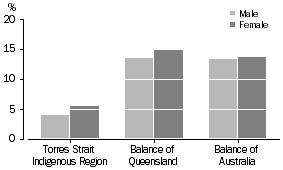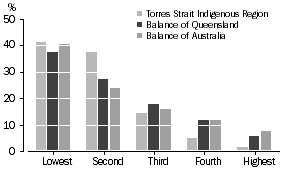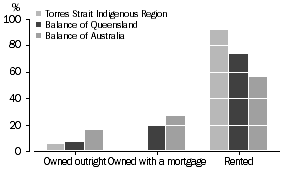TORRES STRAIT ISLANDERS
INTRODUCTION
This chapter presents information for all persons of Torres Strait Islander origin living in the Torres Strait Indigenous Region (see Glossary for geographical coverage), those living in other parts of Queensland and those living elsewhere in Australia. Information separately identifying Torres Strait Islander people has been collected since the 1971 Census. The 1996 Census was the first Census in which people could identify or be identified as being of both Torres Strait Islander and Aboriginal origin. In this publication, Indigenous people reporting dual origin have been included in the Torres Strait Islander population.
In 2006, the estimated resident population (ERP) was 53,300 people of Torres Strait Islander origin, accounting for 10% of the Indigenous population and 0.3% of the total Australian population. This estimate includes 20,200 people of both Torres Strait Islander and Aboriginal origin.
The age distribution of Torres Strait Islander people (based on 2006 Census counts) was similar to that of the overall Indigenous population. A high proportion of Torres Strait Islander people were aged under 15 years (38%). Only 10% of Torres Strait Islander people were aged 55 years or over. In 2006, 15% of Torres Strait Islander people lived in the Torres Strait Indigenous Region, 46% lived in the rest of Queensland and 39% in the remainder of Australia.
Proportions presented in this chapter exclude not stated responses, and are therefore calculated using only known responses. Where possible, the numbers of unknown responses are noted in the tables, allowing further analysis if required.
Language
Torres Strait Islander people living in the Torres Strait Indigenous Region were the most likely to speak a Torres Strait Island language at home (73%) compared with 9% of Torres Strait Islander people living in the rest of Queensland and 1% of Torres Strait Islander people living in other parts of Australia. The most widely spoken Indigenous language by Torres Strait Islander people was Torres Strait Creole with a total of 5,300 speakers, or 12% of Torres Strait Islander people. The next most widely spoken Torres Strait Island language was Kalaw Kawaw Ya/Kalaw Lagaw Ya with 1,100 speakers or 2% of Torres Strait Islander people.
In 2006, 13% of Torres Strait Islander people living in the Torres Strait Indigenous Region who responded to the language question spoke only English at home, compared with 82% in the rest of Queensland and 91% living in other parts of Australia.
Education
A higher proportion of Torres Strait Islander people aged 15 years and over living in the Torres Strait Indigenous Region (38%) had completed Year 12 compared with 35% in the rest of Queensland and 25% in other parts of Australia. In comparison, 22% of all Indigenous people aged 15 years and over had completed Year 12.
In 2006, 23% of Torres Strait Islander people aged 15 years and over had a non-school qualification. A Certificate level qualification was reported by 18% of Torres Strait Islander people aged 15 years and over in the Torres Strait Indigenous Region compared with 15% in both the rest of Queensland and other parts of Australia. A Bachelor degree was reported by 3% of Torres Strait Islander people aged 15 years and over as their highest non-school qualification.
Work
Of Torres Strait Islander people aged 15-64 years who reported their labour force status in the 2006 Census, 55% said they were employed on either a full-time or part-time basis, 8% said they were unemployed and 37% said they were not in the labour force. In comparison, of all Indigenous people aged 15-64 years, 48% reported they were employed, 9% said they were unemployed and 43% said they were not in the labour force.
A higher proportion of Torres Strait Islander people living in the Torres Strait Indigenous Region were employed (69%) than Torres Strait Islander people living in the rest of Queensland (51%) and other parts of Australia (54%).
The labour force participation rate for Torres Strait Islander people living in the Torres Strait Indigenous Region (72%) was higher than the overall Torres Strait Islander participation rate (63%). The labour force participation rate for all Indigenous people was 57%, while the non-Indigenous participation rate was 76%.
Torres Strait Islander people in the Torres Strait Indigenous Region reported a lower unemployment rate (5%) than for all Torres Strait Islander people (12%).
UNEMPLOYMENT RATES (a), Persons aged 15-64 years, Torres Strait Islanders

The most commonly reported occupation group by employed Torres Strait Islander people aged 15 years and over was Labourers (26%), followed by Community and Personal Service Workers (14%) and Technicians and Trades Workers (13%).
The most commonly reported industry by employed Torres Strait Islander people in the Torres Strait Indigenous Region was Public Administration and Safety (66%), followed by Health Care and Social Assistance (10%) and Education and Training (7%). In the remainder of Australia, Manufacturing, Public Administration and Safety, and Health Care and Social Assistance were the most commonly reported industries for Torres Strait Island people (11% each).
CDEP
In 2006, 52% of Torres Strait Islanders living in the Torres Strait Indigenous Region who were employed, were working in the Community Development Employment Projects (CDEP) scheme. CDEP was asked as a separate question only on the Interviewer Household Form. Participation in CDEP was not asked on mainstream forms and therefore it is not possible to compare CDEP participation across different areas.
Income
In 2006, 79% of Torres Strait Islander people in the Torres Strait Indigenous Region had an equivalised gross weekly household income in the lowest two quintiles ($515 or less per week). In the rest of Queensland and the remainder of Australia, 65% of Torres Strait Islander people were in the lowest two quintiles. In comparison, 70% of all Indigenous people had an equivalised gross weekly household income in the lowest two quintiles.
The proportion of Torres Strait Islander people in the highest income quintile ($1,078 per week or more) was 2% in the Torres Strait Indigenous Region, 6% for the rest of Queensland and 8% for the remainder of Australia.
HOUSEHOLD INCOME QUINTILES (a) (b), Residents of occupied private dwellings, Torres Strait Islanders

(a) Based on equivalised gross household income per week. See Explanatory Notes.
(b) Excludes households in which income was partially reported or not stated.
Tenure Type
Torres Strait Islander people were more likely to be renting a dwelling, than to own a dwelling with or without a mortgage. More than two thirds (70%) of the Torres Strait Islander population were living in a rented dwelling, a further 19% were living in a mortgaged dwelling and 10% were living in a dwelling that was owned outright.
TENURE TYPE, Persons in occupied private dwellings, Torres Strait Islanders

In the Torres Strait Indigenous Region, housing co-operative/community/church groups provided rental accommodation for 44% of the 5,700 Torres Strait Islander people in rented housing and the state housing authority provided a further 42%. In 2006, 2% of Torres Strait Islander people living in the Torres Strait Indigenous Region were renting privately compared with 31% in the rest of Queensland and 27% in the remainder of Australia.
A greater proportion of Torres Strait Islander people living in other parts of Australia were owners with a mortgage (27%) compared with 19% in the rest of Queensland and 1% of Torres Strait Islander people living in the Torres Strait Indigenous Region.
 Print Page
Print Page
 Print All
Print All